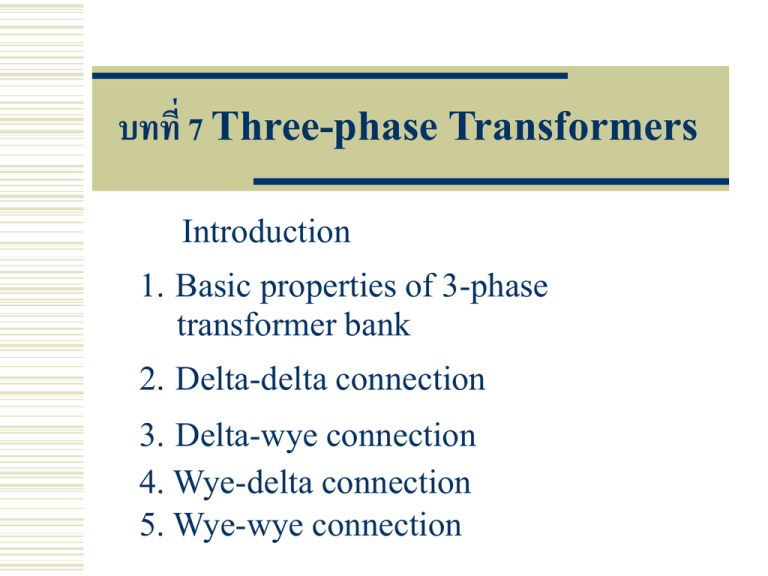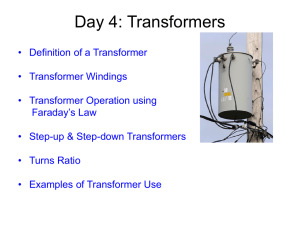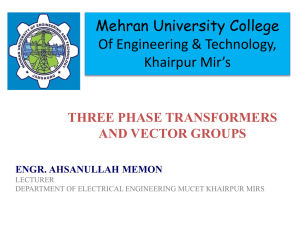Three-phase Transformers
advertisement

บทที่ 7 Three-phase Transformers Introduction 1. Basic properties of 3-phase transformer bank 2. Delta-delta connection 3. Delta-wye connection 4. Wye-delta connection 5. Wye-wye connection Three-phase Transformers 6. Open-delta connection 7. Three-phase transformers 8. Step-up and step-down Autotransformer 9. Phase-shift principle 10. Three-phase to 2-phase Transformation Three-phase Transformers 11. Phase-shift transformer 12. Calculations involving 3-phase Transformers 13. Polarity marking of 3-phase transformers Introduction • The transformers may be inherently 3-phase, having three primary windings and three secondary windings mounted on a 3-legged core. • The same result can be achieved by using three single-phase transformers connected together to form a 3-phase transformer bank. 1. Basic properties of 3-phase transformer bank • When three single-phase transformers are used to transform a 3-phase voltage, the windings can be connected in several ways. the ratio of the 3-phase input voltage to the 3-phase output voltage depends not only upon the turns ratio of the transformers, but also upon how they are connected. • A 3-phase transformer bank can also produce a phase shift between the 3-phase input voltage and the 3-phase output voltage. The amount of phase shift depends upon - the turns ratio of the transformers - how the primaries and secondaries are interconnected Basic properties of 3-phase transformer bank (ต่ อ) • The phase shift feature enables us to change the number of phases a 3-phase system can be converted into a 2-phase, a 5-phase, a 6-phase, or a 12-phase system by an appropriate choice of single-phase transformers and interconnections. Basic properties of 3-phase transformer bank (ต่ อ) • The basic behavior of balanced 3-phase transformer banks is basedon the following simplifying assumptions: (1) The exciting currents are negligible. (2) The transformer impedances, due to the resistance and leakage reactance of the windings, are negligible. (3) The total apparent input power to the transformer bank is equal to the total apparent output power. 2. Delta-delta connection Fig.1 Delta-delta connection of three single-phase transformers. The incoming lines (source) are A, B, C and the outgoing lines (load) are 1, 2, 3. Delta-delta connection (ต่อ) Fig.2 Schematic diagram of a delta-delta connection and associated phasor diagram. Delta-delta connection (ต่อ) • In such a delta-delta connection, the voltages between the respective incoming and outgoing transmission lines are in phase. • If a balanced load is connected to lines 1-2-3, the resulting line currents are equal in magnitude. This produces balanced line currents in the incoming lines A-B-C. • The power rating of the transformer bank is three times the rating of a single transformer. Delta-delta connection (ต่อ) • Example 1 Delta-delta connection (ต่อ) Delta-delta connection (ต่อ) Delta-delta connection (ต่อ) 3. Delta-wye connection Fig.3 Delta-wye connection of three single-phase transformers. Delta-wye connection (ต่อ) Fig.4 Schematic diagram of a delta- wye connection and associated phasor diagram. Delta-wye connection (ต่อ) • The voltage across each primary winding is equal to the incoming line voltage. • However, the outgoing line voltage is 3 times the secondary voltage across each transformer. • The line currents in phases A, B and C are 3 times the currents in the primary windings. •A delta-wye connection produces a 30° phase shift between the line voltages of the incoming and outgoing transmission lines Delta-wye connection (ต่อ) • If the outgoing line feeds an isolated group of loads, the phase shift creates no problem. But, if the outgoing line has to be connected in parallel with a line coming from another source, the 30° shift may make such a parallel connection impossible, even if the line voltages are otherwise identical. • One of the important advantages of the wye connection is that it reduces the amount of insulation needed inside the transformer. The HV winding has to be insulated for only 1/3, or 58 percent of the line voltage. Delta-wye connection (ต่อ) • Example 2 Delta-wye connection (ต่อ) Fig.5 Delta-wye connection (ต่อ) 4. Wye-delta connection • The currents and voltages in a wye-delta connection are identical to those in the delta-wye connection. The primary and secondary connections are simply interchanged. • There results a 30° phase shift between the voltages of the incoming and outgoing lines. 5. Wye-wye connection • When transformers are connected in wye-wye, special precautions have to be taken to prevent severe distortion of the line-to-neutral voltages. (1) connect the neutral of the primary to the neutral of the source, usually by way of the ground Fig.6 Wye-wye connection with neutral of the primary connected to the neutral of the source. Wye-wye connection (ต่อ) (2) provide each transformer with a third winding, called tertiary winding. Fig.7 Wye-wye connection using a tertiary winding. Wye-wye connection (ต่อ) • Note that there is no phase shift between the incoming and outgoing transmission line voltages of a wye-wye connected transformer. 6. Open-delta connection • It is possible to transform the voltage of a 3-phase system by using only 2 transformers, connected in opendelta. • The open-delta arrangement is identical to a delta-delta connection, except that one transformer is absent. • The open-delta connection is seldom used because the load capacity of the transformer bank is only 86.6 percent of the installed transformer capacity. Open-delta connection (ต่อ) • The open-delta connection is mainly used in emergency situations. Thus, if three transformers are connected in delta-delta and one of them becomes defective and has to be removed, it is possible to feed the load on a temporary basis with the two remaining transformers. Fig.8a Open-delta connection. Open-delta connection (ต่อ) • Example 3 Open-delta connection (ต่อ) • The current Is in lines 1, 2, 3 cannot, therefore, exceed 250 A (Fig.8b). Consequently, the maximum load that the transformers can carry is Fig.8b Open-delta connection Associated schematic and phasor diagram. Open-delta connection (ต่อ) 7. Three-phase transformers • A transformer bank composed of three single-phase transformers may be replaced by one 3-phase transformer. • For a given total capacity, a 3-phase transformer is always smaller and cheaper than three single-phase transformers. • Nevertheless, single-phase transformers are sometimes preferred, particularly when a replacement unit is essential. Three-phase transformers (ต่อ) Fig.9 Three-phase transformer for an electric arc furnace, rated 36 MVA, 13.8 kV/160 V to 320 V, 60 Hz. The secondary voltage is adjustable from 160 V to 320 V by means of 32 taps on the primary winding (not shown). The three large busbars in the foreground deliver a current of 65,000 A. Other characteristics: impedance: 3.14%; diameter of each leg of the core: 711 mm; overall height of core: 3500 mm; center line distance between adjacent core legs: 1220 mm. (Courtesy of Ferranti-Packard) Three-phase transformers (ต่อ) Fig.10a Core of a 110 MVA, 222.5 kV/34.5 kV, 60 Hz, 3-phase transformer. By staggering laminations of different widths, the core legs can be made almost circular. This reduces the coil diameter to a minimum, resulting in less copper and lower I2R losses. The legs are tightly bound to reduce vibration. Mass of core: 53,560 kg. Three-phase transformers (ต่อ) Fig.10b Same transformer with coils in place. The primary windings are connected in wye and the secondaries in delta. Each primary has 8 taps to change the voltage in steps of ±2.5%. The motorized tap-changer can be seen in the right upper corner of the transformer. Mass of copper: 15,230 kg. Three-phase transformers (ต่อ) Fig.10c Same transformer ready for shipping. It has been subjected to a 1050 kV impulse test on the HV side and a similar 250 kV test on the LV side. Other details: power rating: 110 MVA/146.7 MVA (OA/FA); total mass including oil: 158.7 t; overall height: 9 m; width: 8.2 m, length: 9.2 m. (Courtesy of ABB) 8. Step-up and step-down Autotransformer • When the voltage of a 3-phase line has to be stepped up or stepped down by a moderate amount, it is economically advantageous to use three single-phase transformers to create a wye-connected autotransformer. Fig.11a Wye-connected autotransformer. Step-up and step-down Autotransformer (ต่อ) Fig.11b Wye-connected autotransformer associated schematic diagram. Step-up and step-down Autotransformer (ต่อ) • For a given power output. an autotransformer is smaller and cheaper than a conventional transformer. This is particularly true if the ratio of the incoming line voltage to outgoing line voltage lies between 0.5 and 2. Step-up and step-down Autotransformer (ต่อ) Fig.11c Single-phase autotransformer (one of a group of three) connecting a 700 kV, 3-phase, 60 Hz transmission line to an existing 300 kV system. The transformer ratio is 404 kV/173 kV, to give an output of 200/267/333 MVA per transformer, at a temperature rise of 55°C. Cooling is 0A/FA/F0A. A tertiary winding rated 35 MVA, 11.9 kV maintains balanced and distortion-free line-to-neutral voltages, while providing power for the substation. Other properties of this transformer: weight of core and windings: 132 t; tank and accessories: 46 t; oil: 87 t; total weight: 265 t. BIL rating is 1950 kV and 1050 kV on the HV and LV side, respectively. Note the individual 700 kV (right) and 300 kV (left) bushings protruding from the tank. The basic impulse insulation (BIL) of 1950 kV and 1050 kV expresses the transformer's ability to withstand lightning and switching surges. (Courtesy of Hydro-Quebec) Step-up and step-down Autotransformer (ต่อ) • Example 4 Step-up and step-down Autotransformer (ต่อ) Step-up and step-down Autotransformer (ต่อ) 9. Phase-shift principle • A 3-phase system enables us to shift the phase angle of a voltage very simply. Such phase shifting enables us to create 2-phase, 6-phase, and 12-phase systems from an ordinary 3-phase line. • Such multiphase systems are used in large electronic converter stations and in special electric controls. Phase shifting is also used to control power flow over transmission lines that form part of a power grid. Phase-shift principle (ต่อ) • To understand the phase shifting principle, consider a rheostat connected between phases B and C of a 3phase line. Fig.12 Voltage EAP can be phase-shifted with respect to EAC by means of a potentiometer. Phase-shift principle (ต่อ) • Such a simple phaseshifter can only be used in circuits where the load between terminals A and P draws a few milliamperes. If a heavier load is applied, the resulting IR drop in the rheostat completely changes the voltage and phase angle from what they were on open-circuit. Fig.13 Autotransformer used as a phase-shifter. Phase-shift principle (ต่อ) Fig.14 Three-phase phase shifter. • This arrangement enables us to create a 3phase source P1, P2, P3 whose phase angle changes stepwise with respect to source ABC. We obtain a maximum phase shift of 60 as we move from one extremity of the autotransformers to the other. 10. Three-phase to 2-phase Transformation • The voltages in a 2-phase system are equal but displaced from each other by 90°. • There are several ways to create a 2-phase system from a 3-phase source. (1) Use a single-phase autotransformer having taps at 50 percent and 86.6 percent. (2) Scott connection. Three-phase to 2-phase Transformation (ต่อ) (1) Use a single-phase autotransformer having taps at 50 percent and 86.6 percent. Fig.15 Three-phase to 2-phase Transformation (ต่อ) • The ratio of transformation (3-phase voltage to 2-phase voltage) is fixed and given by EAB/EAT = 100/86.6 = 1.15. Three-phase to 2-phase Transformation (ต่อ) • The Scott connection has the advantage of isolating the 3-phase and 2-phase systems and providing any desired voltage ratio between them. • Except for servomotor applications, 2-phase systems are seldom encountered today. Three-phase to 2-phase Transformation (ต่อ) (2) Scott connection : It consists of two identical singlephase transformers, the one having a 50 percent tap and the other an 86.6 percent tap on the primary winding. Fig.16 Three-phase to 2-phase Transformation (ต่อ) Example 5: A 2-phase, 7.5 kW (10 hp), 240 V, 60 Hz motor has an efficiency of 0.83 and a power factor of 0.80. It is to be fed from a 600 V, 3-phase line using a Scott-connected transformer bank (Figure 16c). Calculate (a) The apparent power drawn by the motor (b) The current in each 2-phase line (c) The current in each 3-phase line Three-phase to 2-phase Transformation (ต่อ) Three-phase to 2-phase Transformation (ต่อ) Fig.16c Three-phase to 2-phase Transformation (ต่อ) 11. Phase-shift transformer • A phase-shift transformer is a special type of 3-phase autotransformer that shifts the phase angle between the incoming and outgoing lines without changing the voltage ratio. Fig.17 Phasor diagram showing the range over which the phase angle of the outgoing line can be varied. Phase-shift transformer (ต่อ) • The basic power rating of the transformer (which determines its size) depends upon the apparent power carried by the transmission line, and upon the phase shift. • For angles less than 20°, it is given by the approximate formula ST = 0.025 SL max (1) Phase-shift transformer (ต่อ) Example 6: A phase-shift transformer is designed to control 150 MVA on a 230 kV, 3-phase line. The phase angle is variable between zero and t 15°. Calculate (a) The approximate basic power rating of the transformer. (b) The line currents in the incoming and outgoing transmission lines. Phase-shift transformer (ต่อ) Phase-shift transformer (ต่อ) • Fig.18a is an example of a 3-phase transformer that could be used to obtain a phase shift of, say, 20 degrees. Fig.18a Fig.18b Phase-shift transformer (ต่อ) • In our particular example, if E is the line-to-neutral voltage of the incoming line, the respective voltages across the windings of phase A are Fig.18c 12. Calculations involving 3-phase transformers • The behavior of a 3-phase transformer bank is calculated the same way as for a single-phase transformer. In making the calculations, we proceed as follows: (1) We assume that the primary and secondary windings are both connected in wye, even if they are not.This eliminates the problem of having to deal with delta-wye and delta-delta voltages and currents. (2) We consider only one transformer (single phase) of this assumed wye-wye transformer hank. Calculations involving 3-phase transformers (ต่อ) (3) The primary voltage of this hypothetical transformer is the line-to-neutral voltage of the incoming line. (4) The secondary voltage of this transformer is the line-toneutral voltage of the outgoing line. (5) The nominal power rating of this transformer is onethird the rating of the 3-phase transformer bank. (6) The load on this transformer is one-third the load on the transformer hank. Calculations involving 3-phase transformers (ต่อ) Example 7: The 3-phase step-up transformer is rated 1300 MVA, 24.5 kV/345 kV, 60 Hz, impedance 11.5 percent. It steps up the voltage of a generating station to power a 345 kV line. (a) Determine the equivalent circuit of this transformer, per phase. (b) Calculate the voltage across the generator terminals when the HV side of the transformer delivers 810 MVA at 370 kV with a lagging power factor of 0.90. Calculations involving 3-phase transformers (ต่อ) Calculations involving 3-phase transformers (ต่อ) Fig.19 Calculations involving 3-phase transformers (ต่อ) Calculations involving 3-phase transformers (ต่อ) Calculations involving 3-phase transformers (ต่อ) Calculations involving 3-phase transformers (ต่อ) Calculations involving 3-phase transformers (ต่อ) 13. Polarity marking of 3-phase transformers • The HV terminals of a 3-phase transformer are marked H1, H2 , H3 and the LV terminals are marked X1, X2, X3. The following rules have been standardized: Polarity marking of 3-phase transformers (ต่อ) Fig.20 Polarity marking of 3-phase transformers (ต่อ) 3. These rules are not affected by the phase sequence of the line voltage applied to the primary side.




